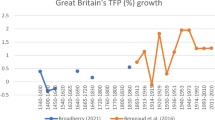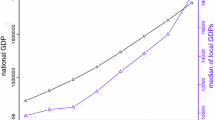Abstract
This study first explores why the shares of factor inputs have not been measured correctly and concludes that the earlier findings are biased due to the miscalculation of factor shares which have produced low estimated total factor productivity (TFP) growth in the East Asian countries. Second, three approaches are proposed to empirically illustrate the impact of capital and labor shares on the estimates of TFP growth. It is suggested that TFP growth in the East Asian economies will be understated if net indirect taxes and imperfect competition profit are ignored. Finally, by taking the net indirect taxes and imperfect competition profits into account, the result of this paper indicates that Taiwan's economy has enjoyed an average annual TFP growth rate of 3.6% over the period 1980–1999.
Similar content being viewed by others
References
Aw, B. Y. (1993). “Price Discrimination and Markups in Export Markets.” Journal of Development Economics 42(2), 315–336.
Barro, R. J. (1999). “Notes on Growth Accounting.” Journal of Economic Growth 4(2), 119–137.
Chang, C. C. and Y. H. Luh. (1999). “Efficiency Change and Growth in Productivity: The Asian Growth Experience.” Journal of Asian Economics 10(4), 551–570.
Chen, Edward K. Y. (1997). “The Total Factor Productivity Debate: Determinants of Economic Growth in East Asia.” Asian Pacific Economic Literature 11(1), 18–38.
Collins, S. M. and B. P. Bosworth. (1996). “Economic Growth in East Asia: Accumulation Versus Assimilation.” Brookings Papers on Economic Activity 2, 135–191.
Drysdale, P. and Y. Huang. (1997). “Technological Catch-up and Economic Growth in East Asia and the Pacific.” Economic Record 73(222), 201–211.
Fare, R., S. Grosskopf and D. Margaritis. (2001). “APEC and the Asian Economic Crisis: Early Signals from Productivity Trends.” Asian Economic Journal 15(3), 325–341.
Felipe, J. (1999). “Total Factor Productivity Growth in East Asia: A Critical Survey.” Journal of Development Studies 35(4), 1–41.
Fischer, S. (1993). “The Role of Macroeconomic Factors in Growth.” Journal of Monetary Economics 32(3), 485–512.
Fuess, S. M., Jr. and H. Van den Berg. (1996). “Transactional Activities and Total Factor Productivity Growth in Taiwan.” Journal of Asian Economics 7(4), 635–650.
Hall, R. E. (1988). “The Relation between Price and Marginal Cost in U.S. Industry.” Journal of Political Economy 96(5), 921–947.
Hsieh, C.-T. (1999). “Productivity Growth and Factor Prices in East Asia.” American Economic Review 89(2), 133–138.
Hu, S.-C. and Vei-lin Chan. (1999). “The Determinants of Total Factor Productivity in Taiwan.” Industry of Free China 89(9), 1–50 (in Chinese).
Hulten, C. R. and F. C. Wykoff. (1981). “The Measurement of Economic Depreciation.” In Charles R. Hulten (eds.), Depreciation, Inflation, and the Taxation of Income from Capital. Washington, D.C.: Urban Institute Press, pp. 81–125.
Jorgenson, D. W., F. M. Gollop and B. M. Fraumeni. (1987). Productivity and U.S. Economic Growth. Cambridge, Mass.: Harvard University Press.
Kim, E. (2000). “Trade Liberalization and Productivity Growth in Korean Manufacturing Industries: Price Protection, Market Power, and Scale Efficiency.” Journal of Development Economics 62(1), 55–83.
Kim, J. I. and L. J. Lau. (1994). “The Sources of Economic Growth of the East Asian Newly Industrialized Countries.” Journal of the Japanese and International Economies 8(3), 235–271.
Klenow, P. J. and A. Rodriguez-Clare. (1997). “The Neoclassical Revival in Growth Economics: Has It Gone Too Far?” In Ben S. Bernanke and Julio J. Rotemberg (eds.), NBER Macroeconomics Annual 1997. Cambridge and London: MIT Press.
Krugman, P. (1994). “The Myth of Asia's Miracle.” Foreign Affairs 73(6), 62–78.
Liang, C.-Y. (1995). “The Productivity Growth in Asian NIE: A Case Study of the Republic of China, 1961–93.” APO Productivity Journal, Asian Productivity Organization, Tokyo, Japan, winter.
Mankiw, G. N. (1997). Macroeconomics. 3rd ed. N.Y.: Worth.
Morrison, C. J. (1990). “Market Power, Economic Profitability and Productivity Growth Measurement: An Integrated Structural Approach.” NBER Working Paper No. 3355.
Nadiri, M. I. and S. Kim. (1996). “R&D, Production Structure and Productivity Growth: A Comparison of the US, Japanese, and Korean Manufacturing Sectors.” NBER Working Paper No. 5506.
Republic of China, Directorate-General Budget, Accounting, and Statistics. (2000). The Trends in Multifactor Productivity, Taiwan Area, Republic of China, Executive Yuan, R.O.C.
Sarel, M. (1995). “Growth in East Asia: What We Can and What We Cannot Infer from It?” IMF Working Paper 95/98.
Sarel, M. (1997). “Growth and Productivity in ASEAN Countries.” IMF Working Paper 97/97.
Temple, J. (1997). “St. Adam and the Dragons: Neo-Classical Economics and the East Asian Miracle.” Oxford Development Studies 25(3), 279–300.
The World Bank. (1993). The East Asian Miracle: Economic Growth and Public Policy. Oxford and New York: Oxford University Press.
Young, A. (1992). “A Tale of Two Cities: Factor Accumulation and Technical Change in Hong Kong and Singapore.” In Olivier J. Blanchard and Stanley Fischer (eds.), NBER Macroeconomics Annual. Cambridge and London: MIT Press.
Young, A. (1994). “Lessons from the East Asian NICs: A Contrarian View.” European Economic Review 38(3–4), 964–973.
Young, A. (1995). “The Tyranny of Numbers: Confronting the Statistical Realities of the East Asian Growth Experience.” Quarterly Journal of Economics 110(3), 641–680.
Author information
Authors and Affiliations
Rights and permissions
About this article
Cite this article
Sun, Ch. Market Imperfection and Productivity Growth—Alternative Estimates for Taiwan. Journal of Productivity Analysis 22, 5–27 (2004). https://doi.org/10.1023/B:PROD.0000034689.54305.bc
Issue Date:
DOI: https://doi.org/10.1023/B:PROD.0000034689.54305.bc




